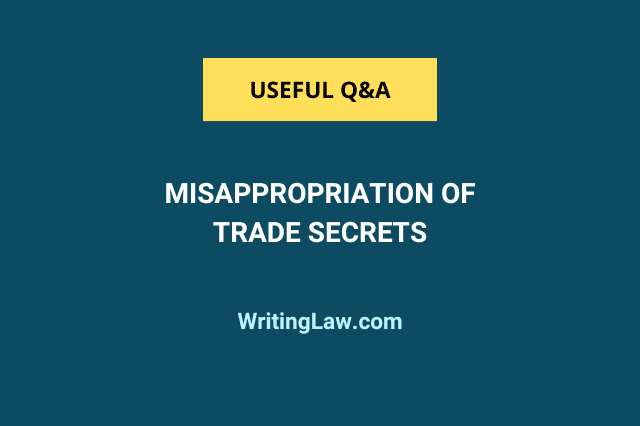
What Are Trade Secrets?
Trade secrets are valuable pieces of commercial or technical information that are not publicly known and are safeguarded by their owners to maintain a competitive advantage. They could include formulas, designs, processes, or other proprietary information that gives a business an edge in the market. Unlike patents or copyrights, trade secrets are protected without formal registration, relying instead on the owner’s efforts to keep them confidential.
Examples: McDonald’s creation of Maharaja Mac’s special sauce, ingredients in Listerine mouthwash, and KFC’s secret blend of 11 herbs and spices — are all trade secrets.
Misappropriation of Trade Secrets
Misappropriation of trade secrets occurs when someone inappropriately acquires, uses, or discloses a trade secret without authorization. This could happen through theft, bribery, breach of confidentiality agreements, or other illicit means. Misappropriation violates the rights of the trade secret holder and can result in legal action to protect the secret and seek compensation for damages.
Elements of Misappropriation of Trade Secrets
1. Secrecy of Information: The information claimed as a trade secret must indeed be secret and not generally known or readily accessible to others dealing with such information.
2. Improper Acquisition: The defendant must have obtained the trade secret through improper means, including theft, bribery, breach of confidentiality agreements, or other forms of deception. This obligation can arise from various legal relationships, such as employment or contractual agreements.
3. Reasonable Steps to Maintain Secrecy: The owner of the trade secret must have taken reasonable measures to protect the secrecy of the information and imparted it under circumstances that imply an obligation of confidentiality.
4. Unauthorized Use or Threat of Use: There must be evidence of the defendant’s unauthorized use of the trade secret, resulting in harm or detriment to the party who owns or communicates the secret. This could include the actual use of the secret or a credible threat of its use.
General Defences for Misappropriation of Trade Secrets
1. Information was in the public domain: The information claimed to be a trade secret was already known to the public, so it cannot be considered a secret anymore.
2. Information was not a trade secret: The information in question does not meet the criteria to be classified as a trade secret because it lacks commercial value or is commonly known in the industry.
3. Information was wrong: The alleged trade secret information is incorrect, so it cannot be protected as a valid secret.
4. Owner of the trade secret did not take enough care to protect: The owner of the trade secret did not take reasonable steps to keep the information confidential, making it susceptible to disclosure.
5. The defendant has no express or implied obligation to maintain secrecy: The defendant had no legal obligation to keep the information confidential, either explicitly stated or implied.
6. The defendant has arrived at the information through independent study, skill, or labour: The defendant obtained the information through their efforts, such as independent research or reverse engineering, without access to the plaintiff’s confidential information.
Case Law
In the case of Tata Motors Limited & Anr vs State of West Bengal, Tata Motors petitioned against the State of West Bengal regarding the disclosure of a Memorandum of Agreement (MOA) related to setting up an automobile plant in Singur, West Bengal, to manufacture the Tata Nano car. Tata Motors argued that the information in the MOA was commercially confidential and should not be disclosed as it could harm its competitive position.
Despite their objections, the State Chief Information Commissioner ordered the disclosure of the MOA under the Right to Information Act, 2005. Tata Motors contended that subsequent developments, including their decision to withdraw the project from Singur and relocate it to Sanand, Gujarat, made the information in the MOA irrelevant. They sought a declaration that the proceedings initiated by the Chief Commissioner were illegal and void.
The High Court of Kolkata, in its deliberations, referred to the definition of “trade secret” as provided by Black’s Law Dictionary. This definition, the court noted, encompasses any formula, process, device, or other business information that is kept confidential to retain a competitive advantage. The court further clarified that such information could include a wide range of items, such as formulas, patterns, compilations, programs, devices, methods, techniques, or processes.
The court emphasised two critical criteria for identifying a trade secret:
- Independent Economic Value: The information must have either actual or potential economic value because it is not generally known or readily accessible to others who could benefit from its disclosure or use.
- Reasonable Efforts to Maintain Secrecy: The owner of the information must have taken reasonable measures, given the circumstances, to maintain its confidentiality.
After careful consideration, the High Court held that the MOA indeed contained commercially confidential information that constituted trade secrets. The court recognised that the disclosure of the MOA would significantly harm Tata Motors’ competitive position. In light of this, the court ruled in favour of Tata Motors, declaring the Chief Commissioner’s order for disclosure illegal and void.
- What Is Misappropriation of Trade Secrets and Its Defences? - 15th May 2024
- 7 Important Types of Mediation Briefly Defined - 14th May 2024
- Whirlpool India vs Videocon Industries – Case Explained - 13th May 2024







